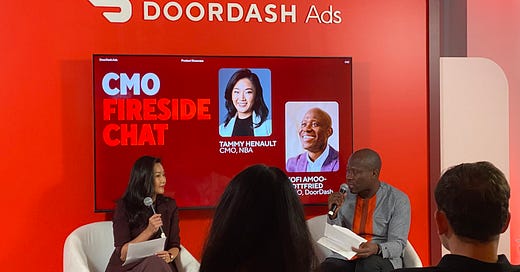Breaking: DoorDash Buys Symbiosys as Ad Network Hits $1B Run Rate
New Smart Targeting & Campaigns target SMB merchants
At the DoorDash Ads Summit in New York City, the food delivery giant gathered marketing luminaries as it unveiled its newest products and acquisitions.
Modern Delivery was on site to get you the key details, below in this special update.
Ads, ads, ads! DoorDash certainly had advertising top of mind as CMO Kofi Amoo-Gottfried gathered industry stakeholders to the company’s Manhattan outpost for its inaugural Ads Summit. The mood was celebratory, as DoorDash proudly shared that its advertising network — both domestically and internationally under the Wolt brand — now operates at a $1 billion+ run rate, with 150,000+ advertisers across 30 countries.
For years, we’ve quipped that delivery and mobility apps just need to run at break even, so they can make their real money off of high-margin ads. With Uber first hitting $1B in ad sales last year, and DoorDash now doing so as well, it seems the prophecy has finally been fulfilled, except with the added kicker that the big two 3PDs are now reliably printing profits as well. In a little jab at the competition, DoorDash called out that it hit the $1B mark in 2024 after just three years of operations, making it the fastest-growing retail media network in history.
DoorDash has been on an acquisition spree as of late - snapping up reservation and CRM platform SevenRooms, making an offer for Deliveroo, and even raising billions in new debt to fund future purchases — and that shows no signs of slowing down, as the company’s just acquired NYC-based Symbiosys for $175 million. While the two have been working closely together for nearly two years, this tie-up strengthens the DoorDash ad platform’s reach, letting advertisers easily deploy campaigns to Google, Snap, Meta, TikTok, The Trade Desk and more.
DoorDash is also doubling down on new tools designed to make advertising easy for small and medium sized businesses that might not have great technical proficiency, with the launch of Smart Targeting and Smart Campaigns. The former targets customers based on order behavior, so a merchant can look for say potential customers with a high propensity to order chicken wings. The latter automates the entirety of the campaign, handling bidding, formatting and optimization.
Vassili Samolis, Head of Product, Ads, on the Quest to Build a “Best in Class” Advertising Platform
To get more details on why DoorDash was so fired up about these new products, I sat down with Vassili Samolis, the company’s Head of Product, Ads. He comes from a long background in adtech, having previously lead teams at the likes of Pinterest and Instagram, and views this latest challenge as his chance to build a “best in class” platform “where local businesses get a fighting chance.” And unlike social media networks, ads on food delivery networks tie back to the physical world, and have real world constraints — say a restaurant that already operates at full capacity during the lunch rush but not for the rest of the day — which he thinks makes this the last frontier in the ad space.
Samolis is building an ad platform that’s “hyper focused on the customer,” but he believes that following that north star ultimately benefits merchants as well. One example — instead of paying on a cost per click or impression basis, restaurants only pay on a cost per acquisition basis. That means if you’ve run an ad for those juicy new chicken wings, you only end up paying DoorDash if a customer ultimately places an order from your restaurant. (And for you adtech nerds, DoorDash uses a 7-day attribution window.)
As DoorDash has made its big push into new verticals, DoorDash is of course rolling out new ad tools geared for alcohol and CPG brands as well. Those bigger advertisers pay on a more traditional CPC or CPM model, with DoubleDash proving to be a particularly lucrative moment to upsell some booze to diners that aleady have a meal on their way. I think this is part and parcel with DoorDash’s recent improvements to unified search, where certain products on the marketplace are now fully commoditized. A bottle of Jack Daniel’s is the same no matter which merchant sells it, and so that creates a somewhat different relationship between the parties, where the only real factor to win on is price…
While these updates have been in the works for some time now, Samolis sees this as just the start of a “three to four year journey” to make the ad products even more world class. He hinted at more integrations and tie-ins, perhaps even the idea that advertisers could one day tap into off-screen ad formats. One thing he wasn’t interested in was making DoorDash’s ad inventory available to outside advertising networks, as that would give up too much control of the experience. The ad team’s passion for their new products was palpable, bordering on feeling mission driven; as Samolis put it, “this is the moment where local businesses gets a fighting chance.”
Got a tip, feedback, or just want to say hi? Reply back to this email.
— Brought to you by the Curbivore Crew.





